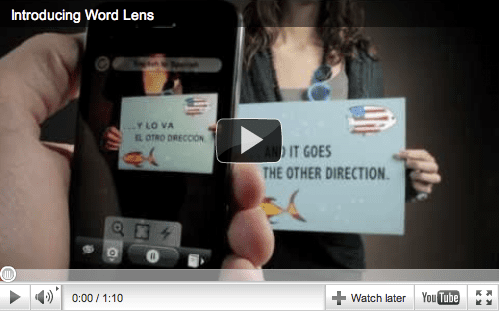For the last couple of months my team and I have been researching interesting new start ups to bring to Connected Creativity at MIPTV. We compiled a list of over 100. Priya, Kevin, Liz and I then sat in a room for an afternoon and looked at each one.
Below are five that really impressed all of us. They signal some interesting trends in the content space, including content creation without human intervention.
1) Qwiki.com – The rise of the text to speech sites has created Qwiki.com a multimedia website which links a robotic reading of a text summary drawn from any chosen Wikipedia article with still and moving images drawn from many sources across the web. It is backed by Facebook co-founder Eduardo Saverin, and YouTube co-founder Jawed Karim with $8 million in funding.
Take a look at this video of a demo the founders of Qwiki gave at Tech Crunch Disrupt. I like the idea of an “information experience” and that the Qwiki site has no human intervention when creating the Qwikis (the demo really kicks off at 1.55 min)
2) Word Lens by Questvisual.com – Word Lens is an augmented reality translation application for the iPhone from Quest Visual. Word Lens uses the built-in phone camera to identify text, such as a sign or a menu, in one language and have the words shown translated into another language.
This video does a great job of showing how the product works:
3) QR Codes are gaining popularity around the world. If you have ever wanted to create your own QR code but were unsure how to do it, Bee Tagg creates them quickly and easily in a few steps. Very impressive. However, the site looks like it was built in 2004.
This is one of the videos I found about the service but it is not very good. My suggestion is to try creating a tag and then be impressed by how easy it is to do with their tools.
4) wireWAX is the world’s first and only user-tagging tool. wireWAX follows (or tracks) the person or object throughout the scene and creates a fluid and natural user experience for both adding tags and interacting with them. The only way to truly understand the scale of this idea is go to to the site and watch their video.
5) Tineye.com from Idee Inc. – Tin Eye is a reverse image search engine. Give Tin Eye an image to find out where else it appears on the web.
Here is great video about how it works:
These are just a few of the 100 companies we looked at. I will have 5 more in my next post.
McGarry is the president of Jumpwire Media and host of MIP Markets’ crossmedia wrap-up sessions. He is guest blogging for MIPBlog in the run-up to MIPTV‘s new gadgets-meet-content event, Connected Creativity. More soon!





2 Comments
Pingback: Tweets that mention Gavin McGarry: 5 New StartUps You Should Know About | MIPBlog -- Topsy.com
Hi to all, I’m the CEO of http://www.plinkers.tv. This is what we call a Product Linking Company. Actually we are positioned on the same market than WireWax and offering more or less the same kind of services. However we consider we are not competitors but may be more partners ! Even if, like they did we previously focused on the interface. On that point I confess that WireWax solution is really “wahou” ! It’s nice looking, fully autonomic for the client so that fit completely to VCs requirements who only focus on “scalable solutions”.
Nevertheless, I would like to share my analysis of the market. As even if that “in video contextual links” is a high potential market, It remains some major challenges to solve. WireWax is surely part of the solution but I think that Plinkers is also.
As you can imagine, the remaining goal for any “video enrichment” company is : how to make my solution standard and fitting to mass market requirements !
To reach those goals we first have to answer/solve the following questions :
1- Which Interface ?
Player overlay + Mouse (Over the video, Beside the video, Below the video..)
Second Screen (Smartphone, Tablets)
TV Overlay + telecommande
2- Which technology ?
Flash ? HTML5 ? Sylverlight ? Quicktime ? Java ? C++ ?
3- Which platform integrates our solution ?
Brightcove, Ooyala, YouTube, Dailymotion, Vimeo, Our own player, the consumer electronics environement …
All those questions are still remaining unanswered ! You’d tell me that it’s not a big deal. It is always the same for innovative companies. So we have to take some risks and choose the right techno and options. It’s part of our vision and finaly it’s a “bet”. That’s true !
However from our side and after 2 years studying / testing the market and the value chain, we identified some other more important problems :
4- who is supposed to tag/enrich the videos ? The producers ? The distributors ? A thrid part ?
Actually we understood on the market that actually the distributors which are usually the one who sell the links wants to keep the hand on the enrichment. So they ask for an autonom solution. But, at the end of the day they don’t use it for several reasons. It’s too much time consuming. That time is always fluctuant. They always need some features which are not planned in the solutions. And the content of the dialog bubble inside the video have a short life cycle as the video has a long one.
5- Who is supposed to market the links inside the bubble ?
For the same reasons as previously explained. Distributors always want to keep the hand on the marketing of the links. However it requires some solutions/skills that distributors doesn’t usually have. If you want to drive users from objects to eshops or brands website you should have a very very large affiliation platform. Otherwise you are very user deceptive as you propose only few links inside the video. Then you also have to get those links UPDATED. And this is almost an impossible challenge if you are not sharing the job with some other platform !
6- Where do you the details about the products inside the video ?
Everybody considers that the details inside the bubble are easy to know as the producers know them. That could be true.. But in reality, for the moment none of the producers we collaborate with were able to provide to us what we call a “style sheet”. That means that we had to integrate that service in our ecosystem of tools. We have a solution for that but it takes time and money 🙂
7- How do we get the life cycles of products and videos to match together ?
As you know a video has usually a quite long life cycle (especially the premium entertainment ones). However, the products are usually 6 months inStore. This is the time of a “collection”. This is also worst in the cinema. The production period is so long that when the movie gets “on air” the product are usually not anymore in stores !
So what happen after that period. How do we update the bubble in order to continue to offer our service ? Propose some “look like” ? That’s the option that we took. However it makes some problems with the product placement agreement deals with the producers.
8- Who get the revenues ?
Producers ? Distributors ? Artists ? The third company ? Actually it’s quite sure that it’s a revenue share model but how we split the revenues ? And how we organise the redistribution of them. We have also a solution for that but this is really not so easy.. This is also another challenge to handle…
Well, there are some additional questions/problems unsolved but these are the main ones.
So what is the conclusion ? Do we have to forget that “product linking” solution to monetize the online video ?
I don’t think so .. The potential is too high and i even would say that it’s the sens of history (as we say in France)!
However, if you want to meet the mass market you have to delegate that job to a third part company only focus on solving those problems and so, creating some real scale effects. But for the moment the value chain is not completely ready for that. May be it requires a slight dose of “pirate” way and we have to wait a bit that the situation of video monetization get crapper…
We are convinced that producers, disintermediation, product placement and brand integration development will help this way. However for the moment distributors (mainly) keep the market stuck as it is. As they still consider that this is THEIR job even if they are not really able to answer all those challenges. (Even if they progressively understand that it’s actually not so possible for them). They prefer to delay the development of that new opportunity instead of giving it to someone else. However producers understand it quite more and are waiting their time. The time the power on the market will balance and will get them the opportunity to decide and so handle that market.. They are the key of it and they will understand it soon.
However for the moment it’s hard. The market offers only some interesting but “one shot” operations. We can learn & try but not really develop the market. The market requires a big investment, independant from any producers / distributors to go a bit more “pirate” style and shake the value chain. But to us the war won’t be on the interface but on the DATA. And we are on that question. And to solve those challenge we don’t one tool but a complete ecosystem containing more than 5 tools dedicated to solve ALL those challenges… And for that we are completely open to collaborate with Wire Wax 🙂
Sorry for my not perfect english. I hope it’s clear anyway even if this post is a bit long. But as you understood, the market is really much more complex to understand than it seems.